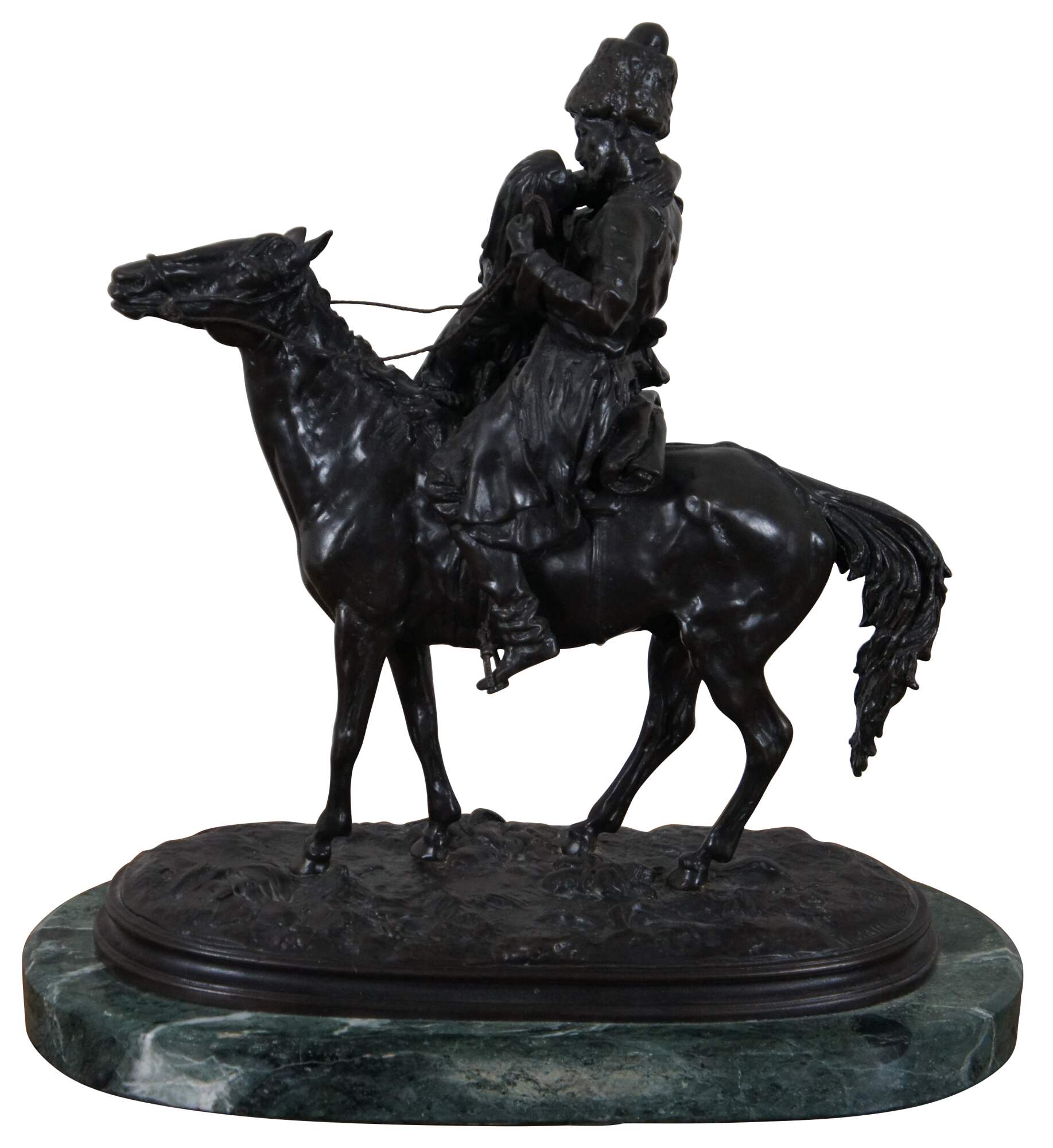
Shipping:
Free Shipping Included
Delivery:
Estimated 2-15 Business Days
Payments:
Credit Card, Check, Cash, PayPal, Apple Pay, Venmo
Returns:
30 Days 100% Money Back Guarantee, Buyer Pays Return Shipping
Description
Antique bronze sculpture from a design by Eugene Lanceray, showing an equestrian scene with a Russian / Cossack soldier seated on a horse, giving his lover / wife a kiss goodbye. Signed in Cyrillic along one edge. Foundry mark not visible. Mounted on a green and white marble base. Attributed to Kasli Haldin.
“Yevgeny Yevgenyevich Lansere, also spelled Eugene Lanceray, was a Russian graphic artist, painter, sculptor, mosaicist, and illustrator, associated stylistically with Mir iskusstva, a revolutionary early 20th century Russian art movement.
Lanceray was born in Pavlovsk, Russia, a suburb of Saint Petersburg. He came from a prominent Russian artistic family. His father was a sculptor. His grandfather Nicholas Benois, and his uncle Leon Benois, were celebrated architects. Another uncle, Alexandre Benois, was a respected artist, art critic, historian and preservationist. His great-grandfather was the Venetian-born Russian composer Catterino Cavos. Lanceray's siblings were also heirs to this artistic tradition. His sister, Zinaida Serebriakova, was a painter, while his brother Nikolai was an architect.
Lanceray took his first lessons at the Drawing School of the Society for the Encouragement of the Arts in St. Petersburg, 1892-1896. He then traveled to Paris, where he continued his studies at the Académie Colarossi and Académie Julian between 1896 and 1899.
After returning to Russia, Lanceray joined Mir iskusstva, the Russian art movement, which was inspired by an artistic journal of the same name, founded in 1899, in Saint Petersburg. Other prominent members of Mir iskusstva included Lanceray's uncle Alexandre Benois, Konstantin Somov, Walter Nouvel, Léon Bakst, and Dmitry Filosofov.
Like other members of Mir iskusstva, he was fascinated with the ""sparkling dust"" of Rococo art, and often turned to 18th century Russian history and art for inspiration.
Lanceray was the only prominent member of Mir iskusstva to remain in Russia after the Revolution of 1917. Even his sister found the revolutionary milieu alien to her art and, in 1924, she fled to Paris.
Lanceray left Saint Petersburg in 1917, and spent three years living in Dagestan, where he became infatuated with Oriental themes. His interest increased during journeys made in the early 1920s to Japan and Ankara, Turkey. In 1920, he moved to Tbilisi, Georgia. During his stay in Georgia, he lectured at the (Tiflis) Tbilisi State Academy of Arts (1922-1934) and illustrated the Caucasian novellas of Leo Tolstoy.
Lanceray left Georgia in 1934, settling in Moscow, where he became involved with decoration of the Kazan Railway Station and the Hotel Moskva. During this same period, Lanceray also worked as a theatrical designer. Three years before his death, he was honored with the Stalin Prize. He died in Moscow at age 71.”
Condition
Very Good
Dimensions
16.5” x 8” x 16.5” (Width x Depth x Height)